This question builds on Extract prediction band from lme fit but with non-linear mixed models.
I have a dataset of response values that are grouped by "entry." I used an AIC-model selection procedure to test which type of model (linear, logarithmic, exponential, etc.) best represented the relationship between the response and predictor. Now I want to plot the fitted values for the data in each entry, and then across entries. I also want to plot the accompanying confidence band on the overall trend--see code provided on Ben Bolker's blog and the post above (I understand this is some finesse to the interpretation but that is another post). The latter is where I'm running into problems--see this example code:
#Load nlme
library(nlme)
#Create data frame
set.seed(6)
df=data.frame(y=c(1:5+runif(5,0,1),21:25+runif(5,1,5)),
x=rep(1:5,2),entry=rep(letters[1:2],each=5))
#Group data by entry
df=groupedData(y~x|entry,data=df)
#Build model
mod=nlme(y~a+b*x,fixed=a+b~1,random=~a+b~1,start=c(a=1,b=1),data=df)
#Create data frame for predictions
pred=do.call(rbind,lapply(rownames(coef(mod)),function(i) {
data.frame(x=seq(0.1,max(df[df$entry==i,"x"]),0.1),entry=i) } ) )
#Grab coefficients from model for a and b
a=coef(mod)[match(pred$entry,rownames(coef(mod))),1]
b=coef(mod)[match(pred$entry,rownames(coef(mod))),2]
#Grab fixed coefficients for overall trend and fitted values for individual entries using a and b above
pred$fixed=fixef(mod)[1]+fixef(mod)[2]*pred$x
pred$fitted=a+pred$x*b
#Get SEs on predictions using code from Ben Bolker's website
predvar=diag(as.matrix(data.frame(a,b)) %*% vcov(mod)%*% t(as.matrix(data.frame(a,b))))
pred$fixed.SE=sqrt(predvar)
pred$fixed.SE2=sqrt(predvar+mod$sigma^2)
#Plot
ggplot()+geom_point(data=df,aes(x=x,y=y),col="grey50",alpha=0.5)+
geom_line(data=subset(pred,max(df$x)>x & x>1),aes(x=x,y=fitted,group=entry),col="grey50")+
geom_ribbon(data=subset(pred,max(df$x)>x & x>1),aes(x=x,ymin=fixed-2*fixed.SE,ymax=fixed+2*fixed.SE),alpha=0.5,fill="grey10")+
geom_ribbon(data=subset(pred,max(df$x)>x & x>1),aes(x=x,ymin=fixed-2*fixed.SE2,ymax=fixed+2*fixed.SE2),alpha=0.3,fill="grey50")+
geom_line(data=subset(pred,max(df$x)>x & x>1),aes(x=x,y=fixed),col="black",lwd=1.1)
The resulting plot looks like this, with the confidence band bouncing back and forth:

I suspect I have gone awry somewhere along the line (perhaps in the matrix multiplication?). Any help is appreciated, including suggestions on whether this is a good idea!